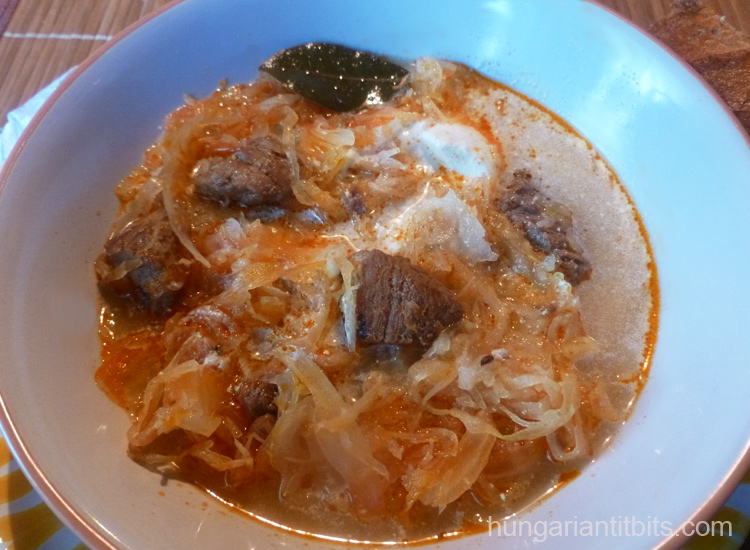
A true winter warmer, made with soured cabbage and tender stewed meat, often seen on the Christmas table too. Usually prepared in large quantities then reheated thoroughly with a bit of water the next day(s) again. Custom says the more you reheat this dish the better it tastes. Always served with chilled sour cream and fresh white bread.
This dish is called “Székely” meaning “Transylvanian” but interestingly it is not named after the Transylvanian region but someone in Hungarian history in the 1800-s whose surname was “Székely” (József Székely, writer) and who is credited with inventing the dish when asking for the meaty paprika stew, porkolt and sour cabbage mixed together when dining out.
Ingredients – for 6 persons
- 700g pork (shoulder is ideal for this)
- 1 big white onion chopped
- 1000g sauerkraut
- 6 tbsp sunflower oil
- 1 tbsp (Hungarian) paprika powder
- 500ml sourcream (350ml to thicken the whole dish, 150ml to serve with)
- 1 tsp caraway seeds, ground or whole
- salt, pepper
- 30g white flour
Method
- Chop the onion and cut the meat into bite sized chunks.
- In a large pot gently fry the onion on the oil, sprinkle in the paprika powder, stir then add chopped meat.
- Season with black pepper, caraway seeds and salt – check how salty your sauerkraut is beforehand, you may have to use less extra salt.
- Cover and cook on moderate heat till the meat is nearly tender, about 40 mins.
- Add the soured cabbage – sauerkraut – and cook till all soft and well cooked.
- In a bowl mix 3/4 of the sour cream and the 30g flour evenly, then combine with some of the hot liquid from the stew till it can be poured into the hot stew. when ready add, stir thoroughly and let it cook for a little bit longer to thicken.
- Serve with white bread on the side and a bit of the rest of the sour cream on top when plated.


More precisely, the creator of this dish was János Székely, county librarian in Buda town, who arrived one day in 1886 too late to the nearby inn to have lunch. As there was only limited choice of food at that hour, on his request the innkeeper mixed the above mentioned leftover ingredients. The improvised dish was tasty and Székely’s friend Sándor Petőfi, Hungarian nation poet witnessing this, next time he ordered the same for himself naming the dish “Székely goulash” though eventually it isn’t goulash. It became popular under this name, the sour cream was added to the recipe later.
(Source: Elek Magyar – Cookbook of the Gourmet Master)
Something wrong. Petofi died in 1849, the lunch date is 1886, so he could not witness it.
Where from do you know the lunch date?
You wote 1886 for the lunch date.
Peter
You absolutely right! I mistyped the date. I wanted to write 1846 instead of 1886. Sorry!
I find that 3-4 crushed garlic cloves enriches the taste.
Also, some red wine – half a cup or even more.
And if you want it extra special, a few
pieces of smoked rib or pieces of smoked turkey leg will do wonders.
My family loves this dish.
I’m sure there would be a dozen more versions of this story, I heard the story from my father who was a Transylvanian and identifyEd as Hungarian, he said Petofi the poet was the hungry guy and the inn was in the Sekely region of transylvania, I’m not sure who Janos was, and probably doesn’t matter because my memory is not good, especially after 50 years.
I’m curious if there is a real, contemporary mention of this entire narrative someplace, or if it was simply made up over time.
History
According to legend, the recipe for this dish is attributed to József Székely, a county archivist from the 19th century who was a contemporary and friend of the Hungarian poet Sándor Petőfi. In 1846, while dining at the Komló Garden on Gránát Street in Pest, they found the available dishes running out. In response to Székely’s request, the innkeeper served a concoction made by mixing leftover sauerkraut stew with pork stew. Allegedly, Petőfi ordered the same dish on a subsequent occasion, referring to it as “Székely-cabbage.”[1]
The recipe is not found in József C. Dobos’s 1881 Hungarian-French cookbook, but it does appear in Ágnes Zilahy’s 1891 “Valódi magyar szakácskönyv” (Genuine Hungarian Cookbook) in the section on side dishes.[2][3]
According to Wikipedia
It’s nice for a legend, but what is the credible evidence that it happened that way? For example, was it written by Petőfi or Székely, or even by the innkeeper or another eyewitness?